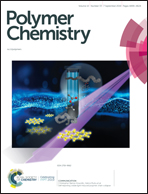The fabrication of hybrid micelles with enhanced permeability for drug delivery via a diethoxymethylsilyl-based crosslinking strategy†
Abstract
Crosslinking based on triethoxysilyl-/trimethoxysilyl functionality has been repeatedly highlighted to be the most frequently used strategy for producing crosslinked organic/inorganic hybrid nanovehicles with enhanced stability for drug delivery applications. However, the permeability of the developed nanocarriers is another critical characteristic and should be simultaneously manipulated to realize sufficient release of the loaded therapeutic cargo in order to give an efficient therapeutic dose. The mainstream strategy to control the permeability of a hybrid nanocontainer is probably a modulation of its crosslinking degree via controlled living polymerization techniques. However, this strategy governed from a macromolecular level still suffered from limited and unsatisfactorily regulation. To exert more precise engineering of the permeability of the hybrid nanocarriers at a molecular level, a novel reducible silica monomer, 2-((2-(methacryloyloxy) ethyl)disulfanyl)ethyl (3-(diethoxymethylsilyl)propyl)carbamate (DESSPMA), with diethoxysilyl groups for in situ crosslinking was designed and synthesized in this study, to produce a lower crosslinking density and greater permeability. In addition to a reducible double-head agent comprising a hydroxyl group and a reversible addition–fragmentation chain transfer (RAFT) agent, a dual reduction-sensitive triblock copolymer, poly(ε-caprolactone)-SS-poly(DESSPMA)-b-poly(oligoethyleneglycol methacrylate) (PCL-SS-PDESSPMA-b-POEGMA), with disulfide bridges located in both the block junction of the polymer backbone and the side chain containing the crosslinking units was prepared by integrated ring-opening polymerization and RAFT polymerization. Notably, greater drug loading capacity and in vitro cytotoxicity of the DESSPMA-based shell crosslinked micelles relative to those of the 2-((2-(methacryloyloxy) ethyl)disulfanyl)ethyl (3-(triethoxysilyl)propyl)carbamate (TESSPMA)-based analogues were realized, which were attributed to the enhanced permeability because of a lower crosslinking density without compromised micelle stability. Therefore the novel diethoxymethylsilyl-based crosslinking strategy developed herein provides a facile and robust route to engineer organic/inorganic hybrid nanocarriers with enhanced therapeutic efficacy.



 Please wait while we load your content...
Please wait while we load your content...